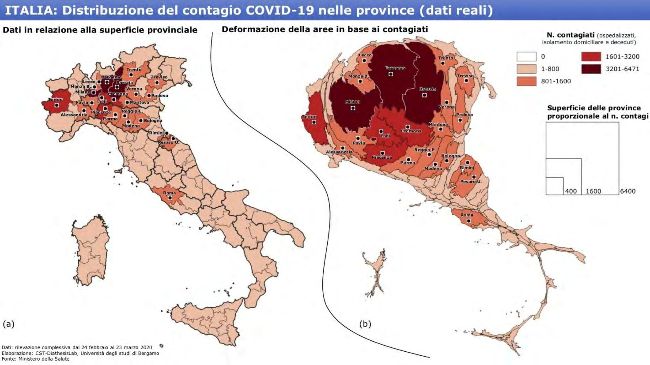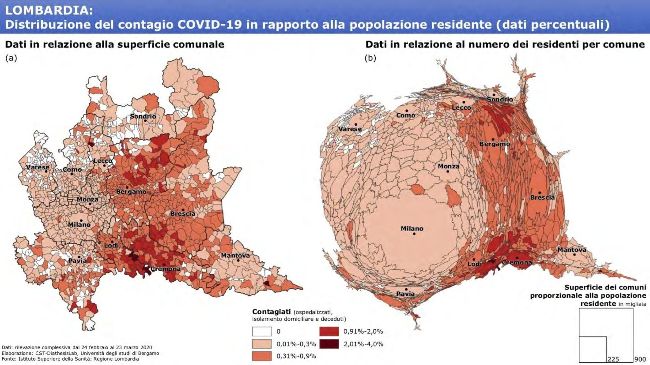Spatial features and contributions from EU projects in Lombardy

Luisa Pedrazzini

ITALY – COVID-19 Contagion distribution by province (real data) (Source: Casti E. Adobati F. (Ed.), 2020 “Rapporto di ricerca n. 3”)
Spatiality is fundamental for understanding phenomena such as the pandemic, particularly when they affect a large European region such as Lombardy in a such a dramatic way.
The high population density (6,000 inhabitants/km2 in Milan), the fact that Lombardy's economy has the highest GDP in Italy, its international relationships and trade partnerships and the state of the Po Valley region, which is affected by the climate emergency and environmental stress, are components of Lombardy's spatiality.
“
An effective response to the COVID-19 emergency has been digitalisation, which was exploited as a powerful tool of resilience and transition
”
The complexity of movements and the intensity of relationships and exchanges suggest that the territorial conditions aid the spread of coronavirus and the intensity of its diffusion.
Analysis and studies show that the virus spreads particularly in areas with high numbers of connections to important transport and mobility hubs and touristic, trade or logistic structures (Casti and Adobati, 2020).
Large outbreaks along the main corridors of mobility axes (the Bergamo valleys) made containment measures difficult and they were implemented at a late stage, resulting in a very high diffusion rate by proximity.
It seems that what Casti and Adobati (2020) call the 'mobile and reticular living' of the Po Valley, with its different territorial features, caused a spread of the COVID-19 virus as a result of both reticularity and proximity.
As asserted in the study of the University of Bergamo (cit.)by Casti and Adobati (2020), the first wave of the virus hit the most internationalised areas, which have high levels of commuting, pollution and trading intensity (import-export).
The second wave is affecting large cities and metro-regions, even where urban density or mobility are only relative factors; it seems that commuting and gatherings in these 'hyperplaces' have become more intense and frequent, which has led to the rise in cases.

LOMBARDIA – COVID-19 Contagion distribution by resident population (percentage) (source: Casti E. Adobati F. (Ed.) 2020 “Rapporto di ricerca n. 3”)
In this fuzzy context, two particular responses by territories should be considered, namely related to the exploitation of connectivity and the potential for digitalisation, and the environmental features of the Po Valley region.
With regard to the first of these aspects, an effective response to the COVID-19 emergency has been digitalisation, which was exploited as a powerful tool of resilience and transition, particularly in the metropolitan region of Milan and in the most urbanised areas.
The most visible evidence of this was the increase in the amount of mobile working, from 2% of the workforce in 2019 to 20% during the Italian lockdown. In this context, Lombardy, which has the highest (49.7%) digitalisation index (DESI) compared with the Italian average (39.2%), improved furtherduring this year.
With regard to environmental features, the morphological structure and climate of North Italy (a greenhouse) does not create favourable environmental conditions in terms of air pollution and public health.
A number of projects endorsed by the EU and dedicated to the support of SMEs and public authorities are relevant to the issues considered here.I
NTER VENTURES (Interreg Europe) and BE-READI ALPS (Interreg Alpine Space), with Unioncamere Lombardia as a project partner, set up a cross-border working group involving public authorities and stakeholders from Lombardy and Switzerland to support competitiveness and internationalisation in border regions and to promote the post-crisis relaunching of SMEs. They arranged innovative online services for distance learning and training and to tackle the crisis in a comprehensive way.
The LIFE PrepAIR project aims to monitor air quality in the Po Valley, where 23 million people live, and which was the region most affected by the first wave of COVID-19 in Italy. The project investigates the interdependencies between human health, the environment and climate, and explores the link between air pollution and the spread of COVID-19. The impact of the lockdown on air pollution and greenhouse gas emissions was studied to improve our understanding of the complex dynamics causing pollution, thereby supporting public authorities to adopt strategies to improve air quality. A special 'Adapting to COVID-19' award from the Directorate-General for the Environment went to PrepAIR.